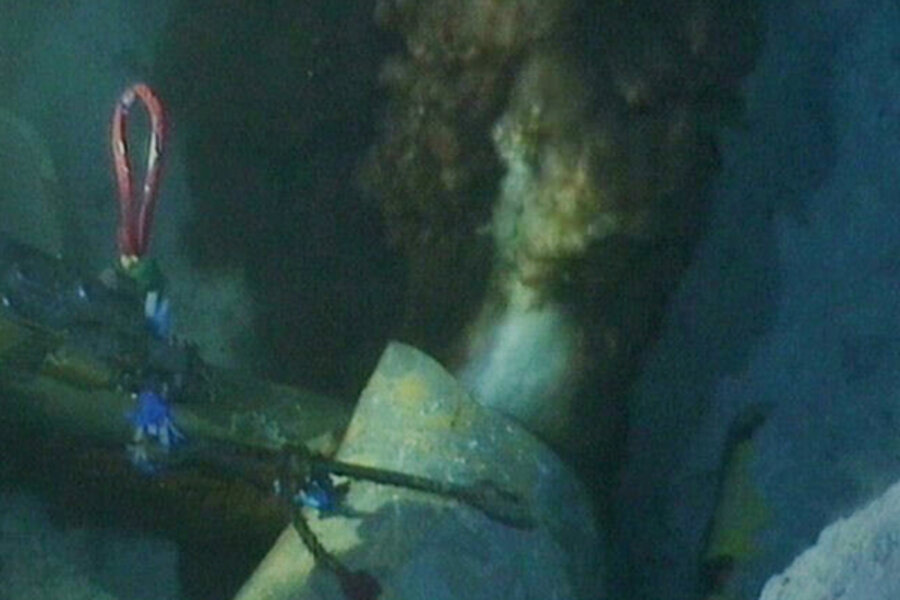Robots trying to siphon Gulf oil spill from broken undersea pipe
Loading...
| Miami, Florida
Undersea robots were trying to thread a small tube into the jagged pipe that is pouring oil into the Gulf of Mexico early Friday in BP's latest attempt to cut down on the spill from a blown-out well that has pumped out more than 4 million gallons (15 million liters) of crude.
The company was trying to move the 6-inch (15-centimeter) tube into the leaking 21-inch (53-centimeter) pipe, known as the riser. The smaller tube will be surrounded by a stopper to keep oil from leaking into the sea. BP said it hopes to know by Friday evening if the tube works and can siphon the oil to a tanker at the surface.
Since the April 20 drilling rig explosion set off the catastrophic spill, BP PLC has tried several ideas to plug the leak that is spewing at least 210,000 gallons of oil into the Gulf a day. The size of the undulating spill was about 3,650 square miles (9,500 square kilometers), said Hans Graber, director of the University of Miami's Center for Southeastern Tropical Advanced Remote Sensing.
IN PICTURES: Louisiana Oil Spill
In the fateful hours before the Deepwater Horizon exploded about 50 miles (80 kilometers) off the Louisiana shore, a safety test was supposedly performed to detect if explosive gas was leaking from the mile-deep well.
While some data were being transmitted to shore for safekeeping right up until the blast, officials from Transocean, the rig owner, told Congress that the last seven hours of its information are missing and that all written logs were lost in the explosion. Earlier tests that suggested explosive gas was leaking were preserved.
The gap poses a mystery for investigators: What decisions were made — and what warnings might have been ignored?
"There is some delay in the replication of our data, so our operational data, our sequence of events ends at 3 o'clock in the afternoon on the 20th," Steven Newman, president and CEO of Transocean Ltd, told a Senate panel. The rig blew up at 10 p.m., killing 11 workers and unleashing the gusher.
Houston attorney Tony Buzbee, who represents several rig workers involved in the accident, questioned whether what he called "the phantom test" was even performed.
"I can just tell you that the Halliburton hands were scratching their heads," said Buzbee, whose clients include one of the Halliburton crew members responsible for cementing the well to prepare for moving the drilling rig to another site.
Details of a likely blowout scenario emerged this week for the first time from congressional and administrative hearings. They suggest there were both crew mistakes and equipment breakdowns at key points the day of the explosion.
Buzbee said that when Halliburton showed BP PLC and Transocean officials the results of the pressure tests that suggested gas was leaking, the rig workers were put on "standby." BP is the rig operator and leaseholder.
Buzbee said one of his clients told him the "Transocean and BP company people got their heads together," and 40 minutes later gave the green light.
The attorney said the Halliburton crew members were not shown any new test results.
"They said they did their own tests, and they came out OK," he said. "But with the phantom test that Transocean and BP allegedly did, there was no real record or real-time recordation of that test."
None of the three companies would comment Thursday on whether any data or test results were purposely not sent to shore, or on exactly who made the final decision to continue the operations that day.
Five thousand feet (1,500 meters) under the sea, if the tube being inserted doesn't work, BP could try a second containment box, which would be placed over the well and also would siphon the oil to the surface.
In another interesting experiment, BP might wind up shooting junk of all shapes and sizes to plug the nooks and crannies into the blowout preventer — a giant piece of machinery that's allowing some of the oil to escape. In the aptly named "junk shot," engineers would shoot pieces of tires, golf balls, knotted rope and other items into it in hopes the right size stuff makes its way to the appropriate holes. Once the leak is clogged, heavy mud will be poured in. It would then be sealed off with cement.
BP also has sprayed chemicals on the oil to break it up into smaller droplets, with about 4 million gallons (15 million liters) of oil-contaminated water recovered.
The size of the spill, as measured from satellites, seems to have grown about 50 percent from May 10 to late Thursday, said Graber from the University of Miami.
"There's a hell of a lot coming out," Graber said of the oil.
The estimate that 210,000 gallons (795,000 liters) are leaking daily comes from the National Oceanic and Atmospheric Administration and has frequently been cited by BP and the Coast Guard. Some scientists have said based on an analysis of BP's video of the leak that the flow rate is much higher, while others have concluded the video is too grainy to draw any such conclusions.
BP is sticking with the NOAA estimate, company spokesman Mark Proegler said Thursday. He said BP hasn't sent down equipment that might be able to more accurately measure the oil because "our focus is on stopping the leak, not measuring it."
Related stories:
Golf balls, new containment dome on deck to stop Gulf oil spill
Exxon Valdez cleanup holds lessons for Gulf oil spill
At Gulf oil spill hearing, plenty of blame, not many answers





